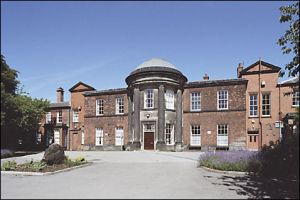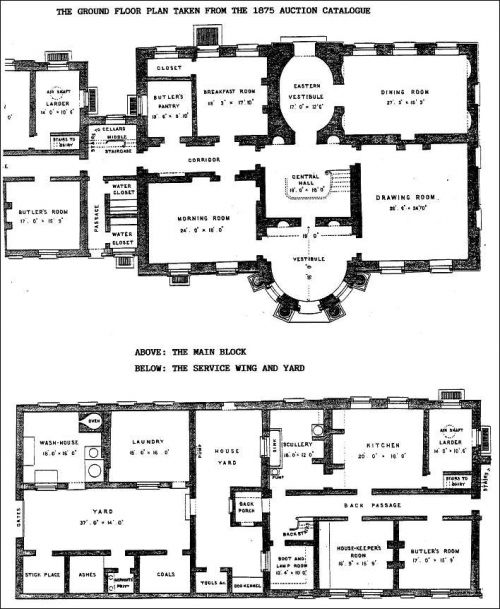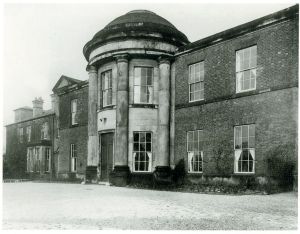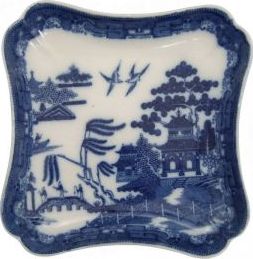- History
- Pottery
- Industry
Housing: The Mount
 The Mount is an imposing neo-classical structure two stories high, and designed in two parts. The smaller building on the northwest side housed the servants and the service catering areas for the main house. Constructed mainly of red brick, the house had seven bays. A large bow built of ashlar with attached Roman Doric columns formed the main structural focus.
The Mount is an imposing neo-classical structure two stories high, and designed in two parts. The smaller building on the northwest side housed the servants and the service catering areas for the main house. Constructed mainly of red brick, the house had seven bays. A large bow built of ashlar with attached Roman Doric columns formed the main structural focus.
In 1838 Josiah Spode III's widow moved out of the house and advertised it to let. The advertisement described the house as comprising , “excellent cellars of good temperature for wine, ground floor, spacious double entrance hall, with handsome stone staircase, dining room, 27 feet by 18 feet, drawing-room, 26 feet by 24  feet, billiard room and library, 24 feet by 18 feet, and breakfast room, 18 feet by 18 feet, all 12 feet 6 inches high. The bed-room floor contains a delightful morning room, with bow window, seven principal bed rooms, to several of which dressing rooms are attached, and a suitable number of convenient sleeping rooms for servants. The domestic offices, which are quite commensurate, adjoin the house, and are equally well built. The stables, coach houses, and harness room, form two sides of a well paved and enclosed yard. Large walled Gardens, stocked with choice fruit trees, in full bearing, hothouse, pinery, green-house, and excellent ice-house. The pleasure grounds are extensive, and tastefully laid out, and include an ornamental sheet of water. This delightful abode, replete with every convenience, is fully adapted to the accommodation of a highly respectable family. It stands upon an eminence, and commands extensive views, including the park, woods, and ornamental grounds of Trentham, Butterton, and Keel. The roads are good in every direction; situated within two miles of Newcastle-under-Lyme; 150 miles from London; and 6 from the Grand Junction Railway station at Whitmore; about 120 acres of Land, together with 9 labourers' cottages, and convenient farm buildings, will be let, if desirable, to a tenant.”
feet, billiard room and library, 24 feet by 18 feet, and breakfast room, 18 feet by 18 feet, all 12 feet 6 inches high. The bed-room floor contains a delightful morning room, with bow window, seven principal bed rooms, to several of which dressing rooms are attached, and a suitable number of convenient sleeping rooms for servants. The domestic offices, which are quite commensurate, adjoin the house, and are equally well built. The stables, coach houses, and harness room, form two sides of a well paved and enclosed yard. Large walled Gardens, stocked with choice fruit trees, in full bearing, hothouse, pinery, green-house, and excellent ice-house. The pleasure grounds are extensive, and tastefully laid out, and include an ornamental sheet of water. This delightful abode, replete with every convenience, is fully adapted to the accommodation of a highly respectable family. It stands upon an eminence, and commands extensive views, including the park, woods, and ornamental grounds of Trentham, Butterton, and Keel. The roads are good in every direction; situated within two miles of Newcastle-under-Lyme; 150 miles from London; and 6 from the Grand Junction Railway station at Whitmore; about 120 acres of Land, together with 9 labourers' cottages, and convenient farm buildings, will be let, if desirable, to a tenant.”
In 1843 local historian John Ward described The Mount, writing "Of the mansions within the Township of Penkhull, (we may say, indeed, within the compass of the Borough,) THE MOUNT, erected by the late Josiah Spode, Esq., bears acknowledged pre-eminence. It stands near the village, and is surrounded by plantations and a highly-ornamental domain. The house is an oblong building of stone, with a semi-circular entrance on the west front; an elegant and lofty dome, which lights the staircase, gives an exterior air of grandeur to the structure."

 In 1851 The Mount was a girls’ boarding school. The national census for that year indicated that Mrs. Sophia Allbut was Principal of the school , which housed English, Music, and French teachers. The girls, between the ages of nine and seventeen, came primarily from industrial towns in the middle of England such as Birmingham, Manchester, Oldham, and Liverpool. Mrs. Allbut's school drew pupils from farther abroad as well, including Calcutta and Switzerland.
In 1851 The Mount was a girls’ boarding school. The national census for that year indicated that Mrs. Sophia Allbut was Principal of the school , which housed English, Music, and French teachers. The girls, between the ages of nine and seventeen, came primarily from industrial towns in the middle of England such as Birmingham, Manchester, Oldham, and Liverpool. Mrs. Allbut's school drew pupils from farther abroad as well, including Calcutta and Switzerland.
By 1897 The Mount became a special school for the education of blind and deaf children. It continued as part of the North Staffordshire school system into the twentieth century. In June 2003 Mr. Paul Wood, Managing Director of Spode, opened the Willows Primary School--named after Spode's world famous "Willow Pattern" pottery.
